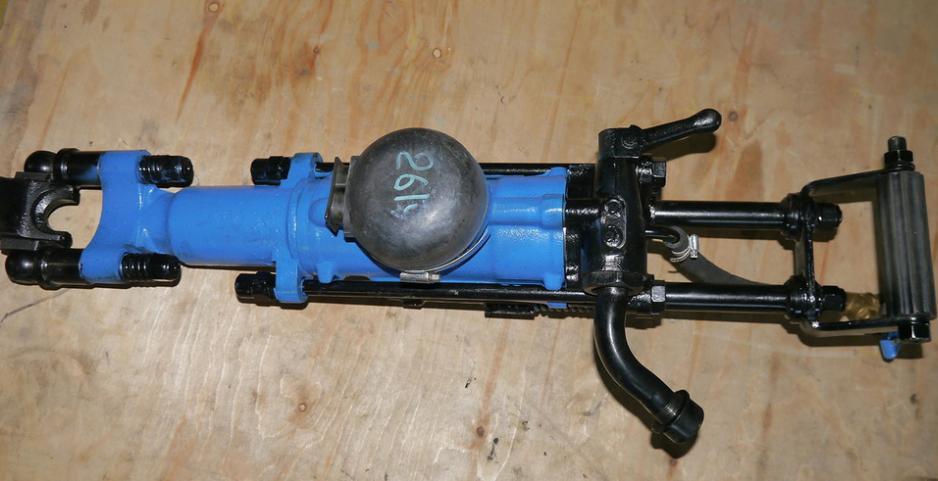The bulk of the punch, presented on the market of construction tools, uses a network or battery cells as a power source. Both categories have their expressed advantages and disadvantages, but in terms of organizing the work process, they mostly have similar features. Fundamentally, a pneumatic rotary hammer differs, which uses compressor equipment as a source of traction. At first glance, this approach to energy supply may seem overly troublesome, but there are significant positive aspects of this tool.
Design features of a pneumatic hammer drill
The basis for the formation of the technical base of the apparatus is still a traditional impact drill that performs the tasks of crushing and drilling with vibrational pulses. But unlike electric rotary hammers, such models have completely redesigned the power infrastructure, adjusted for the use of compressed air as an energy source. In this regard, the set of basic structural and functional units looks like this:
- A housing having an air inlet opening with a pluggable cylinder.
- Ratchet wheel, providing the possibility of interaction of shock jerky action with torque.
- Air ducts through which compressed air is directed.
- Air distribution chamber.
- Piston with cylinder for reciprocating motion.
- Cartridge for nozzle installation.
- A device for supplying water under pressure in order to cool the heated tool bodies.
Depending on the general form factor, stationary and portable small-sized pneumatic perforators can be distinguished. The second category forms the basis of the segment - these are manual models that are used on weight without special support.
Characteristics of a pneumatic hammer drill
Among the main structural and operational indicators, the following should be noted:
- Impact energy. The range of values is quite extensive. Entry-level models provide an impact load of 5-10 J, which is enough to destroy small wall structures and partitions. However, the constant work with solid rocks, asphalt or frozen soil requires the connection of high-performance equipment. These tools include the Russian pneumatic puncher PP-54. Its impact force is 54 J, which is indicated in the name, but there is also a younger version of 36 J.
- The volume of exhaust air. For devices with high impact energy, the flow rate of the air mixture is approximately 3600 l / min, but this value can also vary depending on the current requirements for the operation.
- Engine power. Not all pneumatic models are provided with engines, but such a configuration is found. The average power of power plants for pneumatic rotary hammers is 700-1200 watts.
- Weight. Not always high productivity and power justifies itself precisely in view of the large size and large weight of the tool with such a working potential. Small-sized hand models weigh no more than 5 kg and can be used on weight for a long time, but the massive productive version is used with an inclination according to the principle of a road jackhammer, while having a weight of 10-15 to 30-35 kg.

Features of operation of a pneumatic rotary hammer
The main difference between the working process of a pneumatic hammer drill and conventional percussion drills is the need to connect a compressor unit. This nuance limits the scope of the tool, but at the same time it allows to achieve high power. A compressor hose is connected from the compressor through a special fitting or other connecting equipment. By the way, Bosch pneumatic rotary hammers are provided with a fitting for connecting the 1 / 4F format, and they come with a nipple for the compressor hose.
Positive feedback from tool users
Users of pneumatic drills distinguish their reliability and productivity, which leads to high efficiency when performing various dismantling operations. The benefits are also noted from an economic point of view. Simplifying the design of the tool makes it easier and generally minimizes maintenance costs, while optimizing energy consumption reduces electricity costs. And this is not to mention the praise for the ergonomics of a pneumatic rotary hammer, which has much more modest dimensions and weight compared to ordinary representatives of impact drills and jackhammers.
Negative reviews of pneumatic rotary hammers
You can work with the tool only if you have the option of connecting a compressor. If we are talking about work at a distance, then we will have to provide for special vehicles for transporting equipment. This is the main criticism from the users of this tool. But to this it is worth adding troubles with connecting, since not all compressors are universally combined with manual pneumatic rotary hammers without special adapters.
Conclusion
It is not advisable to purchase a pneumatic hammer drill for performing standard household activities related to the destruction of structures in a house or apartment, since a network impact drill will perform the same work with less organizational effort. Ergonomics will also not be of particular importance, since for one-time events the discount in weight and size is insensitive. But with regular work on construction sites, in road maintenance or in industry, a pneumatic hammer drill will logically take its place. There will be no problems with finding a suitable compressor unit in these areas, as well as with its transportation. But the technique itself of performing complex and critical operations of chiselling, drilling and digging with the help of a powerful apparatus on compressed air will provide an opportunity to save the artist’s strength and extend the working session.